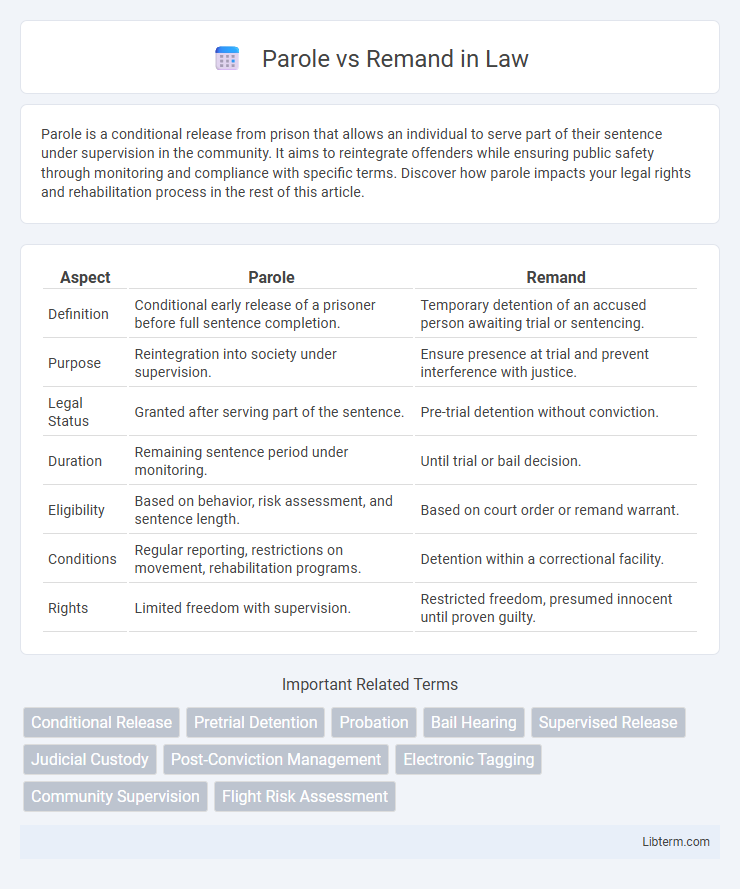Parole is a conditional release from prison that allows an individual to serve part of their sentence under supervision in the community. It aims to reintegrate offenders while ensuring public safety through monitoring and compliance with specific terms. Discover how parole impacts your legal rights and rehabilitation process in the rest of this article.
Table of Comparison
| Aspect | Parole | Remand |
|---|---|---|
| Definition | Conditional early release of a prisoner before full sentence completion. | Temporary detention of an accused person awaiting trial or sentencing. |
| Purpose | Reintegration into society under supervision. | Ensure presence at trial and prevent interference with justice. |
| Legal Status | Granted after serving part of the sentence. | Pre-trial detention without conviction. |
| Duration | Remaining sentence period under monitoring. | Until trial or bail decision. |
| Eligibility | Based on behavior, risk assessment, and sentence length. | Based on court order or remand warrant. |
| Conditions | Regular reporting, restrictions on movement, rehabilitation programs. | Detention within a correctional facility. |
| Rights | Limited freedom with supervision. | Restricted freedom, presumed innocent until proven guilty. |
Introduction to Parole and Remand
Parole is a conditional release of a prisoner before the completion of their full sentence, allowing them to serve the remainder under supervision in the community. Remand refers to the detention of an accused person in custody while awaiting trial or sentencing, without conviction. Understanding the distinct legal statuses and purposes of parole and remand is essential for grasping criminal justice procedures.
Definition of Parole
Parole is the conditional release of a prisoner before completing their full sentence, allowing them to serve the remainder under supervision in the community. It is granted based on factors such as good behavior, rehabilitation progress, and risk assessment, aiming to reintegrate the offender while maintaining public safety. Parole differs from remand, which refers to the temporary detention of an accused person awaiting trial or sentencing, without a conviction.
Definition of Remand
Remand refers to the legal process where an accused individual is placed in custody while awaiting trial or further court proceedings, typically in a jail or detention center. This contrasts with parole, which involves the conditional release of a prisoner after serving part of their sentence. Remand ensures the accused's presence during trial and prevents potential risks such as flight or evidence tampering.
Legal Framework Governing Parole
The legal framework governing parole is established through statutes and regulations that define eligibility criteria, supervision conditions, and the roles of parole boards within the criminal justice system. Parole allows conditional release of prisoners before completing their full sentence, whereas remand refers to the detention of individuals awaiting trial or sentencing. Parole decisions typically involve assessment of the inmate's behavior, risk to society, and rehabilitation progress under specific legal guidelines.
Legal Basis for Remand
The legal basis for remand is primarily grounded in the principles of ensuring a defendant's presence at trial, preventing tampering with evidence, and safeguarding public safety. Courts rely on statutory provisions within criminal procedure codes to justify remand, often contingent upon the severity of the alleged offense and the risk factors associated with release. Unlike parole, which is granted after conviction and service of part of a sentence, remand occurs pre-trial and serves as a preventive detention measure under strict legal frameworks.
Key Differences Between Parole and Remand
Parole allows a prisoner to be released before completing their full sentence under specific conditions, while remand refers to the detention of an individual awaiting trial or sentencing without a conviction. Parole is granted after a portion of the sentence is served and involves supervised freedom, whereas remand is a pre-trial status with no determination of guilt. Key differences include the timing of release, legal status, and conditions imposed on the individual.
Criteria for Granting Parole
Parole is granted based on criteria such as the inmate's good behavior, completion of a specified portion of their sentence, and demonstrated rehabilitation through participation in educational or vocational programs. Authorities also assess the risk of reoffending and the inmate's plans for reintegration, including stable housing and employment prospects. Psychological evaluations and input from victims or community representatives play a key role in determining eligibility for parole.
Circumstances Leading to Remand
Remand occurs when a suspect is held in custody during trial due to factors such as flight risk, danger to public safety, or potential interference with evidence or witnesses. Courts consider the severity of the alleged offense, prior criminal history, and the likelihood of the defendant absconding when deciding remand. This contrasts with parole, where an individual is released early from incarceration under supervision based on good behavior and completion of rehabilitation programs.
Impacts on the Individual: Parole vs Remand
Parole allows individuals to reintegrate into society under supervision after serving part of their sentence, offering opportunities for employment, family reunification, and reduced institutionalization impacts. Remand confines individuals awaiting trial without conviction, often resulting in extended uncertainty, limited access to rehabilitation programs, and adverse mental health effects due to prolonged detention. The contrasting conditions between parole and remand significantly influence the psychological well-being and social outcomes for the individuals involved.
Conclusion: Choosing Parole or Remand
Choosing between parole and remand depends on the legal context, individual case factors, and risk assessments by authorities. Parole allows conditional release of prisoners based on rehabilitation progress, while remand involves temporary detention before trial or sentencing to ensure court appearance. The decision balances public safety, legal procedures, and the rights of the accused or offender.
Parole Infographic

 libterm.com
libterm.com